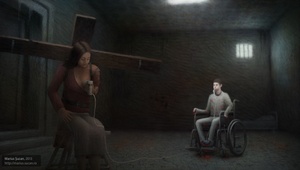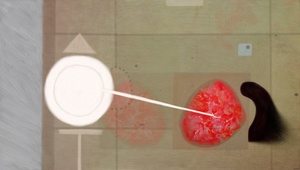Making of: Carita Europeana
Table of contents
- Introduction
- First stages
- Time-lapse images
Introduction
This is the Master's degree dissertation project I did at the „West University of Timişoara” (UVT) where I pursued a Master degree in Art, specialized in Painting. As part of the dissertation project, I was required to write in Romanian a presentation of minimum 50 standard A4 pages, along with the images. The PDF I delivered is around 60 pages.
Download "Carita Europeana" dissertation in Romanian (PDF format)
Artistic interpretation
The concept and idea behind "Carita Europeana" are based on "Carita Romana", a story written by Valerius Maximus, an ancient Roman historian, in around CE 30. Quote from Wikipedia:
"Carita Romana" is the exemplary story of a daughter, Pero, who secretly breastfeeds her father, Cimon, after he is incarcerated and sentenced to death by starvation. She is found out by a jailer, but her act of selflessness impresses officials and wins her father's release. [The story] was presented as a great act of filial piety and Roman honour.
In my interpretation is quite different and personal. I present a disabled boy in a wheelchair indirectly breastfed by his personal caregiver, using a feeding tube and a breast pump, in a cell. The physical disabilities and the isolation are presented as his life long inescapable sentence. The tired woman bears a cross on her back, attached to her with belts, and the door of the cell is open. She has the option to leave. Instead, she chooses to carry on with her life long burden of helping him. The door has steps to emphasize that he cannot escape from his sentence, the exit is not accessible. However, his pose in the wheelchair may suggest he is relaxed about it.
In general, people assume the woman in these paintings represents the mother of the disabled person. The original story of "Carita Romana" gives as well the opportunity to interpret the characters in this way. This interpretation is also backed by the cross she is bearing, to some extent, because for a professional caregiver taking care of the patient is just a job, not a life long burden.
Part 1
The project "Carita Europeana" consists of three parts. In the first part I depict the cell and the characters in a semi-realistic manner, with shadings, lighting and colours. The setup is relatively emotional and atmospheric, gloomy, yet the visual style shows much more detachment than in the second part of the project.
Part 2
The second part is a highly emotional interpretation that elaborates on the subject even further by making use of many symbols and vivid colours. This part is painted as a cartoon, with minimal shading, almost no lighting and vivid colours. The image is dominated by warm and bright colours and it is less intelligible. It is painted to look almost flat. Overall, it is in opposition with the first part: dark / bright colours.
This part of the project is focused more on the disabled person. It is a subjective interpretation of the world he lives in. I suggest he is living in a world animated by fears and by dreams (e.g. the moon, the butterfly). One of his fears is represented by the bed that comes to life. A hand coming out of the bed to grasp the disabled man. The death bed wants to capture him. Inside the room, the colours suggest warmth. Probably, the disabled person is feeling comfortable enough in his world.
In the first two paintings, the boy, painted to look exhausted, is lying in a pool of blood, heavily bleeding to emphasize his strong suffering. The woman is painted having teary eyes as well.
In the second part, most visual elements are dripping, like rain or tears, to echo his emotional state. It is specific in romanticism to have nature echo the feelings of the one in love. In the second part, the light coming through the small window, is a very dark cyan. The outside world is perceived dark and mean, a danger. This is in opposition with the part one, where the light outside was bright, however still painted in cold colours.
The naive and childish illustration style can mirror the emotional underdevelopment of the disabled person. However, it can be viewed from a different perspective as well. The visual style of the picture can be interpreted as a form of irony, sarcasm to the situation of the two characters. A dramatic situation presented naively, in an unexpected and inappropriate way.
Part 3
The third part of the project is an abstract version of the image and it is visually much easier on the eyes. It is executed to look mostly as a flat surface. This image is dominated by warm colours as well.
The bed and the hand are in this part molded into a single black shape. Death came to life and suggestively is taking hold of the red patch. The figurative form is large enough now and is moving towards the left. Visually, the element expresses movement and activity, all other elements are static. Only death seems to be alive in this picture.
The red patch is a collage of wound photographs in a semi-transparent dark square. The disabled is now depicted as vulnerable, as something painful, boxed and constrained, emphasizing he has no escape from his condition. The woman is illustrated as a white circle. In European cultures, white represents purity, innocence and the circle is perfection. The Christian cross is represented by a triangle, reminding of the Trinity in the Christian doctrine.
Project milestones
- 15 October 2012 - Project idea defined
- 5 December 2012 - Work started on the project
- 12 December 2012 - 3D maquette finished
- 16 January 2013 - Sketch finished
- 4 March 2013 - Part 1 partially finished
- 23 March 2013 - Part 2 finished
- 20 April 2013 - Part 3 finished
- 25 April 2013 - Started writing on the dissertation paper
- 10 May 2013 - Part 1 finished
- 25 June 2013 - Finished writing on the dissertation paper
- Project size: 29.1 Gb [727 files]
- Image resolution: 10 000 x 5 650 pixels
My sincere thanks to Daniela Constantin (my professor and project adviser) and to Michael Auerbach for the constant help and support during this highly introspective project.
Next page: First stages


